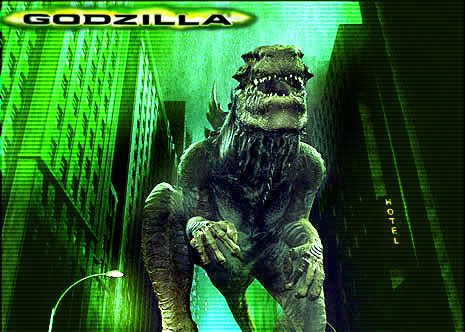
The winter of 1997 ushered in a brief period of time in which Godzilla-fever was rampant in the United States of America, and the world. The original series received multiple re-releases on home video, Trendmaster toys featuring dramatic redesigns of all of Toho’s major players hit toy stores, and books for young and old alike hit retailers. In short, life was good. Roland Emmerich and Dean Devlin’s remake, set to be released that coming May had ensured the Japanese giant was on everyone’s minds, including, of course, the Sci-Fi channel (back when they were still cool) which actually provided coverage of G-Con ‘97, and aired a lengthy movie marathon upon the new film’s release. In fact, most networks were featuring movie marathons that year, with hosts including special effects gurus Ray Harryhausen and Stan Winston. There wasn’t any place you could go without seeing something big and monstrous.
Unfortunately, something happened; Hype backlash. The studio, Tri-Star, held Emmerich and Devlin in such high-regard, that the studio ultimately granted them full creative freedom over the film. In fact, the studio didn’t even host a test screening until but a few weeks before the film’s release (so goes the story, anyway). The movie, simply entitled Godzilla, was a smash-hit all the same. Reviews from most sources, (except Roger Ebert and Gene Siskel), were generally favorable (though few passed up the opportunity to bash the Japanese series). However, the critics generally viewed the movie as being “so bad it’s good” (which is quickly becoming a cliché, if it isn’t already), and saw the film as mere entertainment. Among the movie’s many faults included a weak story of a mutated lizard (making that stereotype official) which arrives in New York City, without much explanation, to lay its eggs. While the movie has a few crowning moments, including some genuinely humorous slapstick, and some interestingly toggled shots, the movie was still far from being the best Godzilla movie to be made.
At first it appeared as though the movie, in spite of massive negative fan reaction, would receive it’s sequel. Godzilla 2 was meant to be released in the next three years, with many critics projecting the sequel to match the first’s box office records. Though Roland Emmerich refused to be attached to the sequel (he would later cite it as his hardest film he did in an interview on the television series “The Directors”), Sony and TriStar were still determined to get the sequel out, and began to look for a replacement director. A representitive from TriStar was even quoted as saying “When a movie makes $400 million, you make a sequel. It’s that simple.”
A sequel eventually did surface on the Fox television network. More specifically, the children’s block. Godzilla: the Series took place immediately after the events of the film, and was immediately well-received. The animated television series was actually praised by fans of the original Godzilla series, and was popular enough to inspire a competing television series on a separate network, Kong: the Animated Series.
At about the same time complaints of the remake were, in fact, being heard. Toho put its special effects crews and suit actors, fresh off of the Rebirth of Mothra series, back to work on its next film, Godzilla 2000: Millennium. Sony was still raking in the cash from merchandizing and decided to distribute the new Japanese Godzilla film to U.S. screens. The movie was, for the most part, well received by the critics with but a few [biased] exceptions. Unfortunately, it was not to be. Godzilla 2000 flopped at the U.S. box office with everyone but the hardcore fans mistaking it for a sequel to Godzilla. The sequel to Emmerich’s Godzilla never was, though the Japanese Godzilla series continued to grace Japanese screens into 2004, and the animated television series enjoyed limited success on U.S. television.
The Monster
Movie Posters
Concept Art
Toys
Books
Merchandise
Copycat Posters & Parodies
Back to Main